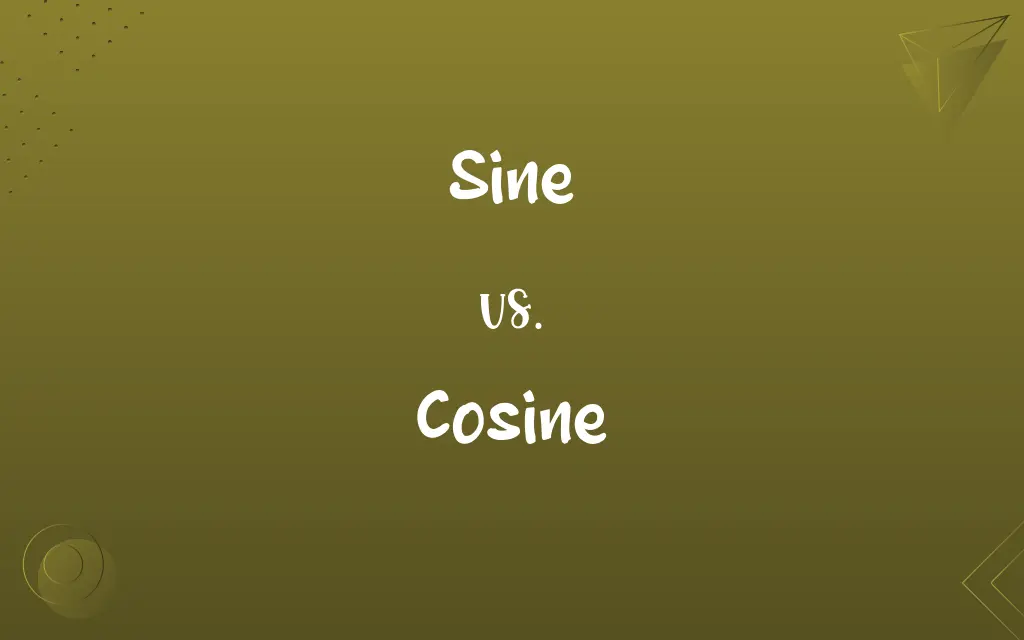Sine vs. Cosine: Know the Difference

By Shumaila Saeed || Updated on December 25, 2023
Sine and cosine are trigonometric functions, sine representing the ratio of the opposite side to the hypotenuse in a right triangle, and cosine the ratio of the adjacent side to the hypotenuse.

Key Differences
Sine (sin) is a fundamental trigonometric function that measures the ratio of the length of the side opposite the angle to the length of the hypotenuse in a right-angled triangle. Cosine (cos), another key trigonometric function, measures the ratio of the length of the adjacent side to the angle to the hypotenuse.
Shumaila Saeed
Nov 15, 2023
In the unit circle, sine of an angle is the y-coordinate of the point where the terminal side of the angle intersects the circle. Cosine, in contrast, is represented by the x-coordinate of this intersection point.
Shumaila Saeed
Nov 15, 2023
The sine function is periodic, repeating every 2π radians or 360 degrees, and its values range between -1 and 1. Cosine function also shares these characteristics, but its waveform is phase-shifted by 90 degrees or π/2 radians.
Shumaila Saeed
Nov 15, 2023
The graph of the sine function starts at the origin (0,0) and moves upwards, while the cosine graph starts at the maximum value of 1 when the angle is zero.
Shumaila Saeed
Nov 15, 2023
In applications, sine is often used to model periodic phenomena such as sound waves. Cosine is similarly used, but its phase difference makes it suitable for different applications like alternating current waveforms.
Shumaila Saeed
Nov 15, 2023
ADVERTISEMENT
Comparison Chart
Definition in Right Triangle
Ratio of opposite side to hypotenuse.
Ratio of adjacent side to hypotenuse.
Shumaila Saeed
Nov 15, 2023
Unit Circle Representation
Y-coordinate of intersecting point.
X-coordinate of intersecting point.
Shumaila Saeed
Nov 15, 2023
Common Applications
Modeling vertical motion in waves.
Modeling horizontal motion in waves.
Shumaila Saeed
Nov 15, 2023
ADVERTISEMENT
Sine and Cosine Definitions
Sine
Sine is the ratio of the opposite side to the hypotenuse in a right triangle.
The sine of 30 degrees is 0.5 in a right triangle.
Shumaila Saeed
Nov 15, 2023
Cosine
In the unit circle, cosine is the x-coordinate of a point.
At 180 degrees, the cosine value is -1.
Shumaila Saeed
Nov 15, 2023
Sine
In the unit circle, sine is the y-coordinate of a point.
At 90 degrees, the sine value reaches its maximum of 1.
Shumaila Saeed
Nov 15, 2023
Cosine
Cosine is the ratio of the adjacent side to the hypotenuse in a right triangle.
Shumaila Saeed
Nov 15, 2023
Sine
A periodic function representing vertical oscillation in waveforms.
Sine waves are commonly used in acoustics to model sound.
Shumaila Saeed
Nov 15, 2023
ADVERTISEMENT
Cosine
A periodic function representing horizontal oscillation in waveforms.
Cosine waves are used to model the voltage in AC circuits.
Shumaila Saeed
Nov 15, 2023
Sine
Sine function varies sinusoidally, repeating every 360 degrees.
The sine of an angle and its supplement are the same.
Shumaila Saeed
Nov 15, 2023
Cosine
Cosine function has a sinusoidal variation, with a period of 360 degrees.
The cosine of an angle and its co-angle are the same.
Shumaila Saeed
Nov 15, 2023
Sine
A function used in trigonometry to solve for unknown angles and sides.
Using sine, we can calculate the height of a tower from a known distance and angle.
Shumaila Saeed
Nov 15, 2023
Cosine
A trigonometric function for calculating unknown angles and sides.
Cosine helps in determining the width of a river from a given point and angle.
Shumaila Saeed
Nov 15, 2023
Sine
The ordinate of the endpoint of an arc of a unit circle centered at the origin of a Cartesian coordinate system, the arc being of length x and measured counterclockwise from the point (1, 0) if x is positive or clockwise if x is negative.
Shumaila Saeed
Oct 19, 2023
Cosine
In a right triangle, the ratio of the length of the side adjacent to an acute angle to the length of the hypotenuse.
Shumaila Saeed
Oct 19, 2023
Sine
In a right triangle, the ratio of the length of the side opposite an acute angle to the length of the hypotenuse.
Shumaila Saeed
Oct 19, 2023
Cosine
The abscissa at the endpoint of an arc of a unit circle centered at the origin of a Cartesian coordinate system, the arc being of length x and measured counterclockwise from the point (1, 0) if x is positive or clockwise if x is negative.
Shumaila Saeed
Oct 19, 2023
Sine
In a right triangle, the ratio of the length of the side opposite an angle to the length of the hypotenuse. Category:en:Trigonometric functions Category:en:Functions
Shumaila Saeed
Oct 19, 2023
Cosine
(trigonometry) In a right triangle, the ratio of the length of the side adjacent to an acute angle to the length of the hypotenuse. Symbol: cos Category:en:Functions Category:en:Trigonometric functions
Shumaila Saeed
Oct 19, 2023
Sine
The length of a perpendicular drawn from one extremity of an arc of a circle to the diameter drawn through the other extremity.
Shumaila Saeed
Oct 19, 2023
Cosine
The sine of the complement of an arc or angle. See Illust. of Functions.
Shumaila Saeed
Oct 19, 2023
Cosine
Ratio of the adjacent side to the hypotenuse of a right-angled triangle
Shumaila Saeed
Oct 19, 2023
Sine
Ratio of the opposite side to the hypotenuse of a right-angled triangle
Shumaila Saeed
Oct 19, 2023
Repeatedly Asked Queries
Are sine and cosine values always between -1 and 1?
Yes, both functions have values ranging from -1 to 1.
Shumaila Saeed
Nov 15, 2023
How are sine and cosine used in the unit circle?
Sine represents the y-coordinate and cosine the x-coordinate of a point on the unit circle.
Shumaila Saeed
Nov 15, 2023
What is the period of sine and cosine functions?
Both functions have a period of 2π radians or 360 degrees.
Shumaila Saeed
Nov 15, 2023
How are sine and cosine graphs different?
The sine graph starts from the origin, while the cosine graph starts from the maximum value.
Shumaila Saeed
Nov 15, 2023
Are there any special angles for sine and cosine?
Yes, angles like 0°, 30°, 45°, 60°, and 90° have known sine and cosine values.
Shumaila Saeed
Nov 15, 2023
What is the sine function?
Sine is a trigonometric function that relates an angle to the ratio of the opposite side to the hypotenuse in a right triangle.
Shumaila Saeed
Nov 15, 2023
What is the cosine function?
Cosine is a trigonometric function that relates an angle to the ratio of the adjacent side to the hypotenuse in a right triangle.
Shumaila Saeed
Nov 15, 2023
Can sine and cosine be used to solve triangles?
Yes, they are key in solving right triangles and in various applications of trigonometry.
Shumaila Saeed
Nov 15, 2023
What is the phase shift between sine and cosine graphs?
There is a phase shift of 90 degrees or π/2 radians, with cosine leading.
Shumaila Saeed
Nov 15, 2023
Can sine and cosine values be negative?
Yes, depending on the angle, both sine and cosine can take negative values.
Shumaila Saeed
Nov 15, 2023
What are the maximum and minimum values of sine and cosine?
Both functions have maximum values of 1 and minimum values of -1.
Shumaila Saeed
Nov 15, 2023
Are sine and cosine functions only for acute angles?
No, they can be used for any angle, including obtuse and reflex angles.
Shumaila Saeed
Nov 15, 2023
Can sine and cosine be defined for complex numbers?
Yes, both functions can be extended to complex numbers.
Shumaila Saeed
Nov 15, 2023
What is the significance of sine and cosine in Fourier series?
They are used to decompose periodic functions into their frequency components.
Shumaila Saeed
Nov 15, 2023
How does the sine of an angle relate to its cosine?
The sine of an angle is the cosine of its complement, and vice versa.
Shumaila Saeed
Nov 15, 2023
Are there inverse functions for sine and cosine?
Yes, the inverse sine (arcsin) and inverse cosine (arccos) functions exist.
Shumaila Saeed
Nov 15, 2023
How do calculators compute sine and cosine?
Calculators use series approximations or algorithms to compute these values.
Shumaila Saeed
Nov 15, 2023
How do sine and cosine relate to the exponential function?
They can be expressed using Euler's formula involving the exponential function.
Shumaila Saeed
Nov 15, 2023
How are sine and cosine used in physics?
They are used to model waveforms, oscillations, and rotational motion.
Shumaila Saeed
Nov 15, 2023
Is there a geometric interpretation of sine and cosine?
Yes, they can be interpreted geometrically using the unit circle.
Shumaila Saeed
Nov 15, 2023
Share this page
Link for your blog / website
HTML
Link to share via messenger
About Author
Written by
Shumaila SaeedShumaila Saeed, an expert content creator with 6 years of experience, specializes in distilling complex topics into easily digestible comparisons, shining a light on the nuances that both inform and educate readers with clarity and accuracy.









































































